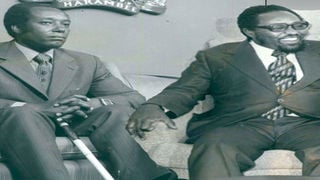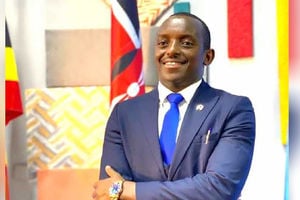
Former Cabinet ministers Dr Njoroge Mungai (left)and Dr Munyua Waiyaki.
| File | Nation Media GroupWeekly Review
Premium
The Mungai, Waiyaki Fort Hare University links that shaped Kenya's policy on apartheid
After the death of South African politician Mangosuthu Buthelezi, somebody asked me about his connection with some Kenyan leaders and why Kenyans were seeking higher education at South Africa’s Fort Hare University.
One doesn’t have to look deeper. In his biography by Ben Temkin, Buthelezi says he shared a rondavel with Kenya’s Dr Njoroge Mungai and Dr Munyua Waiyaki – who later became Cabinet ministers in Kenyatta and Moi regimes. But there is more to it. Fort Hare shaped Africa’s nationalism to an extent.
Out of the experiences that Dr Mungai and Dr Waiyaki had in South Africa, they managed to shape Kenya’s position towards the apartheid regime when they were Foreign ministers. They always quoted their first-hand experiences.
Once upon a time, while interviewing Dr Waiyaki, he retrieved some Fort Hare pictures and told me that Charles Njonjo used to spot communist beards. I later sat with Njonjo and asked him about his communist ideals, and he quipped: “We were students and everybody was a communist then.”
Interestingly, they all followed different ideological paths. But the most interesting is that Dr Waiyaki and Dr Mungai – out of their South African experience – became some of the most vocal critics of apartheid.
As Foreign ministers, Dr Mungai and Dr Waiyaki occasionally had meetings with Buthelezi and supported his refusal to turn Zululand into a Bantustan state – some pseudo-self-governing entities created by the apartheid regime to keep Black South Africans from demanding South African citizenship.
Buthelezi had then established the Inkatha Freedom Party as one of the largest formations in South Africa. Fort Hare’s place in molding a generation of African leaders is now part of history.
Founded in 1916 to train indigenous Africans and looked down on by other scholarship sites, it shaped the ideology of African leaders.

Dr Njoroge Mungai.
While marking the institution’s centenary in 2016, Zimbabwe’s President, the late Robert Mugabe, described Fort Hare as “the Cradle of Africa’s anti-colonial ideology and seminal source of Africa’s intellectualism”.
“It was here that I discovered my African identity,” said Mugabe, a former alumnus.
This university produced Presidents Nelson Mandela, Sir Seretse Khama, Julius Nyerere, Yusuf Lule, and Kenneth Kaunda and party leaders such as Oliver Tambo, the revered leader of the African National Congress, and Robert Sobukwe of Pan Africanist Congress.
Other leaders included Zimbabwe’s Joshua Nkomo – who would later use Fort Hare graduates to organise Zimbabwe’s liberation movement. Among the recruits was Robert Mugabe.
It was not by chance that Fort Hare became attractive to Kenyan students.
In 1936, when the colonial secretary W. Ormsby Gore (later Lord Harlech) appointed a commission on the workings of Makerere College, a delegation from Fort Hare – on its way to Makerere – passed by Alliance High School. The delegates consisted of Fort Hare’s first principal, Alexander Kerr, and Zachariah K. Mathews; a pioneer black academic in South Africa. During this time, they met George Grieve, the Alliance High School principal, who had asked them to spend a few days at the school.
“Before our visit to Kikuyu two Kenyan students studying for the Presbyterian ministry had spent two years in the divinity course at Fort Hare, and we were pleased to renew our friendship with them. Afterwards we learned that they had proved worthy pastors, though one, to our sorrow, died early,” Kerr later wrote in his autobiography.
Fort Hare had some Presbyterian links, and those students who wanted to avoid following the colonial oriented education at Makerere opted for Fort Hare. Fort Hare had its origins in liberal missionary education, and historians consider it as the “shibboleth of modern Africa nationalism.” It was one of the early incubation centers of an African elite that was also internationalist.

President Jomo Kenyatta with his cabinet on January 22, 1965. The cabinet Mzee Kenyatta formed in 1963 included such giants as Jaramogi Oginga Odinga, Thomas Joseph Mboya, Joseph Murumbi, Julius Kiano, Mbiyu Koinange, Njoroge Mungai, Ngala Mwendwa, and Ramogi Achieng Oneko.
However, not all students at Fort Hare emerged as critics of South Africa’s apartheid regime. Take Charles Njonjo – later Kenya’s attorney general – as an example. It is well known that Njonjo fell in love with South Africa, and despite the apartheid system, he used to believe that the best approach was to improve diplomatic relations.
In 1973, while touring South Africa, Njonjo had told an Afrikaans newspaper, Rapport, that there was nothing to hinder South African tourists from visiting Kenya.
Njonjo had many friends in South Africa and counted Fort Hare-trained Transkei’s head of state’, Chief Kaizer Matanzima, as his friend. Njonjo and Mantazima shared the same political thoughts.
Fort Hare treats Njonjo as one of its most prominent alumni. Njonjo went to Fort Hare in 1943 and graduated in 1945. The records in Fort Hare indicate that he had enrolled for an MA, but he transferred to the University of Exeter.
It seems that Njonjo maintained close links with Fort Hare and would later be close to his former teacher Monica Wilson who taught Fort Hare between 1944 and 1946 when she left for Rhodes University. Monica, while writing Z.K. Matthews’ biography stayed in Njonjo’s Muthaiga house as she interviewed the Fort Hare alumni from Kenya.
Njonjo facilitated the issuance of her visa since South African passport holders were not allowed into Kenya. Another of his contact was the vice-chancellor of the University of Cape Town, Sir Richard Luyt, who would occasionally visit Njonjo’s Muthaiga home.
In Njonjo’s thinking: “The Whites in South Africa are just as native to South Africa as the Blacks. The Whites of South Africa know no other home.” This statement would later be politically suicidal when he faced a Judicial Commission of Inquiry in 1984 that investigated his linkages with apartheid South Africa.
Another Kenyan politician from Fort Hare was Masinde Muliro and he left a mark in national politics. On South Africa, Muliro was the opposite of Njonjo. In 1965, he told the Kenyan Parliament in what looked like a snide at Njonjo: “I was educated in Fort Hare University of South Africa. They taught the philosophy of apartheid there. I never became part of this. I do not discriminate, simply because I was in South Africa, but if I believed in the philosophy of the South African, then I would never have taken the immediate step, on arrival, to join Kenya politics in order to fight for the liberation of my own country. The philosophy there is the humiliation of the black man, but it never humiliated me…”
The same Muliro thoughts could be seen in Dr Mungai, who graduated from Fort Hare in 1950 with a BSC degree before proceeding on a scholarship to Stanford in the US. An exciting story on Mungai is that before he left for Fort Hare, he was driving his father’s bus, named Guthera, which was plying between Limuru and Nairobi.
Upon returning to Kenya, Dr Mungai would join hands with his Fort Hare colleague Dr. Waiyaki, a medical doctor, in pressuring the colonial government to allow African doctors to verify Jomo Kenyatta’s state of health while he was under restriction. That is how a delegation consisting of Dr. Mungai, Dr. Waiyaki, Dr. Jason Likimani, and Dr. James Nesbitt went to see Kenyatta in Maralal.
Interestingly, though they were schoolmates, Njonjo and Mungai would fall out later. Mungai hated the apartheid South Africa, while Njonjo had conservative views. In independent Kenya, Mungai and Waiyaki would become the Kenyatta government’s two most radical anti-apartheid voices. As historian Charles Hornsby noted, Mungai, “despite British wooing, criticised Western links to South Africa in a way that embarrassed the UK on several occasions.”
When Dr Mungai was asked in 1971 whether Kenya would enter into dialogue with South Africa, he said, “if there is to be dialogue the issue of apartheid should be the main subject of discussion…If South Africa is serious about a dialogue with African states, it should enter into one first with its own Black people there whom it has oppressed and treated as sub-human beings over the years.” Wealthy colonial chief Mwendwa Kitavi also took his son, Kyale Mwendwa, to study in Fort Hare. He was part of the set of students from Machakos who arrived in 1948. They included Henry Muli, who graduated with a Bachelor of Science – and later became Kenya’s ambassador to China – and Fred Mati, who read for a BA starting in 1948 and was Speaker of the National Assembly for many years.
In all these, the Presbyterian Church played a significant role in sending students to Fort Hare. For instance, the Akamba Union and the church partly sponsored Henry Muli and Fred Mati. More so, Alliance High School had strong networks with Fort Hare, which belonged to the same network – the Presbyterian Church of Scotland. That explains why Alliance High School students would also find space in Scottish colleges such as New Battle Abbey College, Robert Gordon in Aberdeen, and St Andrews. They could also be enrolled in India’s Erwings Christian College.
For instance, Julius Gecau, later the executive chairman of East African Power and Lighting, refused to join Makerere and did odd business — selling illegal brew — in Nairobi to pay for his passport. He finally registered at Erwings Christian College in Allahabad (Uttar Pradesh), India, to prepare for his university matriculation.
If Buthelezi was a hothead in South Africa, he picked those habits in Fort Hare, which was a breeding ground of African nationalism. Had Dr Waiyaki and Dr Mungai not been in Kenyatta’s Cabinet, perhaps Njonjo would have steered Kenya’s policy towards apartheid differently.
[email protected] Twitter: @johnkamau1





